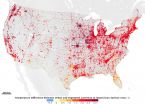Algorithm helps identify elusive genes that express like clockwork
2015-08-25
(Press-News.org) Genes that express in precisely timed patterns, known as oscillatory genes, play an essential role in development functions like cell division, circadian rhythms and limb formation. But without a time-lapse view of genetic expression, these genes have gone largely undiscovered.
An algorithm developed by scientists at the Morgridge Institute for Research and the University of Wisconsin-Madison is giving scientists a new way to identify the dynamics of oscillatory genes, and perhaps defining the roles of these early-development forces for the first time.
A paper published in this week's online edition of Nature Methods describes this new statistical approach, called "Oscope," which helps identify oscillating genes in single-cell RNA-sequencing experiments. The key to Oscope is examining cells from an unsynchronized population, where the cells are in different developmental states.
Studying oscillatory genes using traditional RNA-seq technology requires investigators to "pick" only one known oscillatory system and perform synchronization toward this system. This step masks the oscillatory signals of any other systems.
"We study unsynchronized single cell data here so none of the oscillatory systems are disturbed," says Ning Leng, a computational biologist with the Morgridge Institute and co-author of the paper. "This enables us to discover the unknown oscillatory signals."
Oscope identifies independent groups of cyclic genes and captures one "base cycle" of each group, offering a practical way to profile distinct groups of genes that play a cyclical role. This technology could open new research roads into genes that are at the heart of basic development.
Oscope was born out of an interdisciplinary collaboration. To solve the problem required combining the statistical expertise of Professor Christina Kendziorski's group from the Department of Biostatistics and Medical Informatics at UW-Madison with the cell biology strengths of stem cell research pioneer James Thomson's group at the Morgridge Institute for Research. Leng worked on the project as a graduate student in Kendziorski's group, and joined the Thomson lab upon graduation this fall.
Leng co-authored the paper with Li-Fang Chu, a Morgridge postdoctoral research associate. Both scientists are part of Thomson's Morgridge Regenerative Biology team. Leng began the project in 2013 as a graduate student in Kendziorski's group.
The Oscope software package is offered free to scientists at: https://www.biostat.wisc.edu/~kendzior/OSCOPE/.
"We view this as the first step to understanding oscillatory genes and their relationship to developmental processes," says Chu. "What's most interesting is, how are the genetic regulatory networks governing oscillatory gene expression? How are these signals coordinated in a timely fashion to execute a developmental task?"
The goal of the Thomson lab will be to establish a robust system for the detection of timing-related genes that are important to developmental process, Chu says.
The most well understood oscillatory genes are those related to the circadian clock, which is based on sunlight and tightly regulates metabolism and cell proliferation over a 24-hour period.
There are disease implications as well, says Chu, the most notable being cancer, where the normal timing of cell division is hijacked as cells proliferate out of control. The Oscope technique may identify other connections between genetic cycles and disease.
Single-cell RNA sequencing is an extremely powerful tool for getting snapshots of gene expression, but is less able to trace a cell over time. Oscope uses the high-resolution snapshot data to identify different gene groups that are potentially changing over time.
"We need a combination of an average signal across many cells for the big picture, and we also need single-cell resolution techniques to compare the two and figure out which signal may represent true biological variables," Chu says. "The data analysis is very challenging and requires novel algorithms, such as Oscope, to perform these complex tasks."
INFORMATION:
ELSE PRESS RELEASES FROM THIS DATE:
2015-08-25
As the use of e-cigarettes has risen dramatically in the United States in recent years, so have calls to poison centers about them. Yet many parents who use e-cigarettes - or "vape" - aren't aware of the dangers to children, according to a new study at Washington University School of Medicine in St. Louis.
The devices are used like typical cigarettes but instead of tobacco, they vaporize a liquid mixture of nicotine, glycerin and glycol ethers. The liquid form is flavored, which appeals to children. If ingested, a teaspoon of this "e-liquid" can be lethal to a child, ...
2015-08-25
Less than 10 per cent of paediatric patients who suffer a cardiac arrest outside of the hospital survive. There are many factors which can influence survival rates; paramedic care is one of them.
Thanks to the advanced training of paramedics, today, they can spend more time on the scene doing CPR or providing medical care including administering intravenous fluids and medications. However until now, it has not been known if the length of time spent on the scene and onsite medical interventions by paramedics are associated with improved survival for paediatric patients.
In ...
2015-08-25
Fast Facts:
Inflammatory bowel disease (IBD) has been historically underdiagnosed in African-Americans and is increasing in frequency.
Several gene variants for IBD in whites are key risk factors in African-Americans.
Also important are unique African ancestral variants that cause protection against IBD.
In African-Americans, as in whites and Asians, the dominant region for ulcerative colitis genetic risk in is the human leukocyte antigen region, a major determinant of immune regulation.
Researchers at the Johns Hopkins University School of Medicine, along ...
2015-08-25
NEW YORK, NY (August 25, 2015)-- Klinefelter syndrome is the most common disorder of the male sex chromosomes, yet is rarely diagnosed in children. A new assessment tool is being developed by researchers at Columbia University Medical Center (CUMC) to help pediatricians detect the physical traits of the syndrome. The tool could pave the way for early interventions that prevent and treat a range of physical, psychological, social, and cognitive impairments. The study was published in The Journal of Pediatrics.
According to lead author Sharron Close, PhD, boys with Klinefelter ...
2015-08-25
In the biochemical game of genetics, it was thought that the proteins controlling gene regulation in animals were either spectators or players.
But in research appearing in the current issue of eLife, Michigan State University researchers found that spectator proteins are actually practicing up for the big game. They discovered that the proteins are biochemically interacting with thousands of regions of the genome to change the structure of chromosomal material, although only few of them actually are able to change gene expression.
"The previous thinking was that these ...
2015-08-25
Cities are well known hot spots - literally. The urban heat island effect has long been observed to raise the temperature of big cities by 1 to 3°C (1.8 to 5.4°F), a rise that is due to the presence of asphalt, concrete, buildings, and other so-called impervious surfaces disrupting the natural cooling effect provided by vegetation. According to a new NASA study that makes the first assessment of urbanization impacts for the entire continental United States, the presence of vegetation is an essential factor in limiting urban heating.
Impervious surfaces' biggest ...
2015-08-25
The greater a country's gender equality when it comes to employment, the higher the overall homicide rate, according to a Baylor University study of 146 countries.
"The finding does not mean that gender equality in employment increases homicide rates, but there is a correspondence," said sociologist Katie Corcoran, Ph.D. "What remains uncertain is the 'why' behind this relationship, although prior research suggests it may be due to threatening male status.
"The research findings are significant because they show that gender inequality does not only affect women," she ...
2015-08-25
Genetic findings support observational evidence that lower vitamin D levels are associated with increased risk of multiple sclerosis, according to a new research article by Brent Richards, from McGill University, Canada, and colleagues published this week in PLOS Medicine.
Multiple sclerosis is a debilitating autoimmune disease that affects the nerves in the brain and spinal cord. There is no known cure for multiple sclerosis and it usually presents between the ages of 20 and 40 years. While some observational evidence suggests there may be a link between lower vitamin ...
2015-08-25
A new modeling study appearing this week in PLOS Medicine supports consideration of vaccination campaigns using a single dose of cholera vaccine versus campaigns using the recommended two doses given two weeks apart.. Justin Lessler and colleagues, of Johns Hopkins Bloomberg School of Health, Baltimore, Epicentre, Paris and Médecins Sans Frontières, Geneva focus their modelling analyses on comparing the number of lives that could be saved by adopting a single vaccine dose, which could be more rapidly administered to more people than the internationally licensed ...
2015-08-25
An oral cholera vaccine that is in short supply could treat more people and save more lives in crisis situations, if one dose were dispensed instead of the recommended two, new Johns Hopkins Bloomberg School of Public Health research suggests.
More than 1.5 billion people around the world are at risk for cholera, a severe diarrheal illness caused by bacteria linked to poor water and sanitation. It is a major killer worldwide, causing an estimated two to three million cases and 100,000 deaths each year, primarily in developing nations.
A relatively new vaccine -- internationally ...
LAST 30 PRESS RELEASES:
[Press-News.org] Algorithm helps identify elusive genes that express like clockwork

